
Rick Ryder
Joined May 2020
Why you can trust me: Formerly a Registered Nurse, now Certified Wilderness First Responder (WFR); US Army combat veteran (non-com); decades of prepping experience; off-grid building/living experience; husband, father, grandfather; Extra Class FCC ham radio licensee
Discussions
Reply to: Off-grid cabin/land purchase
Posted December 14, 2022
Reply to: The basic model my family uses for planning to Shelter in place vs Bug out
Posted July 8, 2022
Reply to: The basic model my family uses for planning to Shelter in place vs Bug out
Posted July 8, 2022
Reply to: AR-15 Maintenance Schedules and Guidelines
Posted November 3, 2020
Reply to: The basic model my family uses for planning to Shelter in place vs Bug out
Posted August 1, 2020
The basic model my family uses for planning to Shelter in place vs Bug out
Scenarios 1020
Posted July 31, 2020
Reply to: Common survival myths among preppers
Posted June 8, 2020
The basic model my family uses for planning to Shelter in place vs Bug out
Scenarios 1020
Posted July 31, 2020
Reply to: Off-grid cabin/land purchase
Posted December 14, 2022
Reply to: The basic model my family uses for planning to Shelter in place vs Bug out
Posted July 8, 2022
Reply to: The basic model my family uses for planning to Shelter in place vs Bug out
Posted July 8, 2022
Reply to: AR-15 Maintenance Schedules and Guidelines
Posted November 3, 2020
Reply to: The basic model my family uses for planning to Shelter in place vs Bug out
Posted August 1, 2020
Reply to: Common survival myths among preppers
Posted June 8, 2020